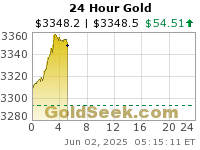*
One of the worst places for an investor to ever be is where everyone else is. Why? Because when someone yells "fire", or in the case of elephants yells "lion", the herd turns abruptly and you, being in the middle of the pack, get trampled.
*
One of the ways we can see where the herd is standing is to look at stuff like the put to call volume ratio of a security, or its short interest - that is the degree to which its shares are sold short. If you find yourself standing where an accumulation of that crowd is standing, run - before it is too late.
*
So where are elephants standing with respect to the stock market right now? This chart of the put to call volume ratio of Direxion 3X Small Cap Bull ETF (TNA) gives us an incredible insight.
*
Click on the charts to ENLARGE
*
*
OK, so where are the elephants hiding with respect to the miners, say, the Market Vector ETF (GDX)?
*
Well, it looks like I see them over there, shorting the GDX ETF like the miners are about to roll over and die. Now that's about as likely as Ben announcing he has changed his mind about doing QE2.
*
And there are more elephants there than ever before. Tisk, tisk, tisk.
*
OK, maybe the crowd had the good sense to stay away from a truly great company with what most will acknowledge has a bullet proof business model - Silver Wheaton (SLW).
*
A look at the chart tells that story.
*
Nope, more elephants than you can shake a stick at and most within 2 inches of each other. Tisk, tisk, tisk - again.
*
When you the TV commentators talk about a "crowded traded", this is what it looks like.
*
Oh well, I guess we need these folks to make a market for the rest of us, right? :-)
Thank you
1 day ago



![[Most Recent Quotes from www.kitco.com]](http://www.kitconet.com/images/quotes_special.gif)




And yet, there is the AAII survey showing the most trader optimism since the April high. Ditto Investors Intelligence. This week's Barron's cover shows a bear getting killed; the last two Barron's covers featuring the relevant stock market animals showed a bull getting killed (March 2009 low) and a bear being flattened by a bus (April 2010 high).
ReplyDeleteSo sentiment is extremely optimistic. Or extremely pessimistic. Take your choice.
To quote the market sage Vinnie Barbarino, "I'm so confused."
Excellent point and very well written. Thank you - I agree with everything you wrote completely. My use of TNA and the put to call volume ratio was admittedly "selective" as I was aware of the other data as well.
ReplyDeleteHonestly, all I am doing with my little TZA trade is following what the TSI and MFI tell me - that the market is going to sag for the next short while.
Does not mean I am right, but I do have money on it.
But the second that TSI information turns on my position I will be long gone...... 'shock and awe', if it comes Wednesday afternoon, will indeed be road kill for anyone on the bear side of the market. That would of course include anyone in possession of TZA, like myself.
Great comment and again, thanks.
Hi John,
ReplyDeleteI'm unclear on the perspective regarding the TNA put/call ratio chart. The TNA chart of the put/call ratio appears to be positively correlated, vs. inversely correlated to the indices, so like April '10 where the put/call ratio was very high it called for a market top and vice-versa for the June/July low. The is the opposite of what you suggested. Any clarification appreciated.
Thanks,
Neil
Neil - the April '10 put/call ratio topped out and THEN TNA rallied another near 20%. It was likely that those getting out of their extremely bearish position had to become buyers to unwind their position - thus creating the ensuing run up in TNA price. Again, some elephants decided to change direction from the herd and everyone staying in the herd was trampled.
ReplyDeleteIn an ideal world, the put/call ratio should always be moving in the opposite direction of price. And as you can see, that rarely happens.
The put/call ratio could also be some big hedging against potential loss. They are always a little earlier on the up side. But the down side is why so correlating. Just another angle for the data.
ReplyDeleteAnon - thank you.
ReplyDelete